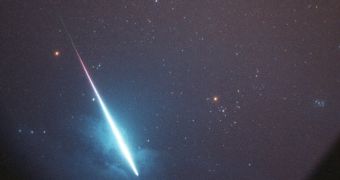The U.S. Pacific Northwest has just experienced an atmospheric meteorite explosion on Tuesday morning. Richard Pugh, a scientist at the Cascadia Meteorite Laboratory of Portland State University in Oregon, said that the lucky ones could find marble to basketball size space rocks in eastern Oregon. The event was witnessed by 40-50 persons. The sky explosion, falling on an east-southeast direction, took place around 5:30 a.m. PT and it was observed over Washington State.
"The light was bright enough to wake up people even though the shades were pulled, and then the sonic boom hit, rattling windows and making the dust fly, and the dogs crawled under the bed. And following the heavy boom, in a number of cases we have rumbling a few minutes later. This kind of sound effect usually indicates there are rocks on the ground," Pugh told National Geographic News.
"Descriptions of the explosion suggest the meteor was rocky and likely sprayed debris over several square miles," he added. Rock fragments coming from the explosion could be found in the prairie outside the town of Pendleton, Oregon, or in the neighboring Blue Mountains.
"Given the likely small size of any impacting fragments in a rural area, chances of recovery are slim. Our hope is that somebody got a rock through a barn roof out there somewhere. An impact site may resemble a divot on a golf course. The rocks could penetrate several inches in wet ground," said Pugh.
Pugh's team is going to search, in the next weeks, the area of potential impact and the researchers will also try to involve local people in this. Eyewitnesses can contact the Cascadia Meteorite Laboratory at (503) 287-6733.
"A private single-engine jet called in a sighting of the fireball Tuesday morning," Mike Fergus, a spokesperson with the Federal Aviation Administration in Seattle, Washington, told National Geographic News.
The bright flash was also seen by other pilots.
"But nobody had seen the meteor body itself, nor the impact," said Fergus.
"Fireball sightings are relatively common in the Pacific Northwest, usually several times a year," said Pugh.
But this impact was remarkable through its size.
"This one was just exceedingly bright and produced an awful lot of noise," said Pugh.

 14 DAY TRIAL //
14 DAY TRIAL //